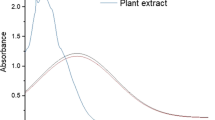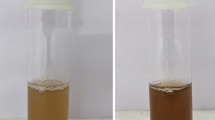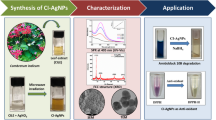Abstract
Herein, we reported the preparation and characterization of silver nanoparticles from Kalanchoe brasiliensis leaves extract and their application in the photocatalytic degradation of Aniline Blue, Toludine Blue, Congo Red, Indigo Carmine, Auramine O, and Pyronin Y dyes. The synthesis of Kalanchoe brasiliensis extract derived silver nanoparticles (KK-AgNPs) was well characterized by several techniques. The surface plasma resonance (SPR) peak of 17 nm sized KK-AgNPs occurred at 445 nm, and the KK-AgNPs were stable for more than five months. Finally, KK-AgNPs were used as a green catalyst for the photocatalytic degradation of the above-mentioned dyes. Interestingly, the KK-AgNPs green catalyst decolorized all six dyes and their mixture. We found high catalytic efficiency up to 86%. Moreover, we used the KK-AgNPs green catalyst to degrade industrial dye effluent water. We also discussed the possible mechanism for the photocatalytic degradation of dyes.
Graphical Abstract










Similar content being viewed by others
Data Availability
Available upon request.
References
Burdusel, A. C., Gherasim, O., Grumezescu, A. M., Mogoanta, L., Ficai, A., & Andronescu, E. (2018). Biomedical Applications of Silver Nanoparticles: An Up-to-Date Overview. Nanomaterials, 8(9), 681.
Mallick, K., Witcomb, M. J., & Scurrell, M. S. (2004). Polymer stabilized silver nanoparticles: A photochemical synthesis route. Journal of Materials Science, 39(14), 4459–4463.
Eswaran, S. G., Narayan, H., & Vasimalai, N. (2021). Reductive photocatalytic degradation of toxic aniline blue dye using green synthesized banyan aerial root extract derived silver nanoparticles. Biocatalysis and Agricultural Biotechnology, 36, 102140.
MubarakAli, D., Thajuddin, N., Jeganathan, K., & Gunasekaran, M. (2011). Plant extract mediated synthesis of silver and gold nanoparticles and its antibacterial activity against clinically isolated pathogens. Colloids and Surfaces B: Biointerfaces, 85(2), 360–365.
de Araujo, E. R. D., Felix-Silva, J., Xavier-Santos, J. B., Fernandes, J. M., Guerra, G. C. B., de Araujo, A. A., de Araujo, D. F. S., de Ferreirae, L. S., da Junior, A. A. S., de Fernandes-Pedrosa, M. F., & Zucolotto, S. M. (2019). Local anti-inflammatory activity: Topical formulation containing Kalanchoe brasiliensis and Kalanchoe pinnata leaf aqueous extract. Biomedicine & Pharmacotherapy, 113, 108721.
Forte, T. O., Alviano, D. S., Tupinamba, G., Padron, T. S., Antoniolli, A. R., Alviano, C. S., & Seldin, L. (2008). Production of an antimicrobial substance against Cryptococcus neoformans by Paenibacillus brasilensis Sa3 isolated from the rhizosphere of Kalanchoe brasiliensis. Microbiological Research, 163(2), 200–207.
Albuquerque, U. P., Patil, U., & Mathe, A. (2018). Kalanchoe brasiliensis Camb. and Kalanchoe pinnata (Lamk.) Pers. Medicinal and Aromatic Plants of South America, 23, 265–273.
Nayak, B. S., Marshall, J. R., & Isitor, G. (2010). Wound healing potential of ethanolic extract of Kalanchoe pinnata Lam. leaf-a preliminary study. Indian Journal of Experimental Biology, 48, 572–576.
Maruthupandi, M., Chandhru, M., Rani, S. K., & Vasimalai, N. (2019). Highly selective detection of iodide in biological, food, and environmental samples using polymer-capped silver nanoparticles: Preparation of a paper-based testing kit for on-site monitoring. ACS Omega, 4(7), 11372–11379.
Gopinath, V., Priyadarshini, S., Loke, M. F., Arunkumar, J., Marsili, E., MubarakAli, D., Velusamy, P., & Vadivelu, J. (2017). Biogenic synthesis, characterization of antibacterial silver nanoparticles and its cell cytotoxicity. Colloids and Surfaces B: Biointerfaces, 10(8), 1107–1117.
Balakumar, V., & Prakash, P. (2016). Ag nanoshell catalyzed dedying of industrial effluents. RSC Advances, 6, 31653–31660.
Chandhru, M., Kutti Rani, S., & Vasimalai, N. (2020). Reductive degradation of toxic six dyes in industrial wastewater using diaminobenzoic acid capped silver nanoparticles. Journal of Environmental Chemical Engineering, 8(5), 104225.
Boga, C., Delpivo, C., Ballarin, B., Morigi, M., Galli, S., Micheletti, G., & Tozzi, S. (2013). Investigation on the dyeing power of some organic natural compounds for a green approach to hair dyeing. Dyes and Pigments, 97(1), 9–18.
Bafana, A., Devi, S. S., & Chakrabarti, T. (2011). Azo dyes: :Past, present and the future. Environmental Reviews, 19(NA), 350–371.
Berradi, M., Hsissou, R., Khudhair, M., Assouag, M., Cherkaoui, O., El Bachiri, A., & El Harfi, A. (2019). Textile finishing dyes and their impact on aquatic environs. Heliyon, 5(11), e02711.
Jansen, M., & Letschert, H. P. (2000). Inorganic yellow-red pigments without toxic metals. Nature, 404(6781), 980–982.
Chandhru, M., Logesh, R., Kutti Rani, S., Ahmed, N., & Vasimalai, N. (2021). Green synthesis of silver nanoparticles from plant latex and their antibacterial and photocatalytic studies. Environmental Technology. https://doi.org/10.1080/09593330.2021.1914181
Chung, K.-T. (2016). Azo Dyes and Human Health: A Review. Journal of Environmental Science and Health, Part C, 34, 233–261.
Navada, K. K., & Kulal, A. (2020). Enhanced production of laccase from gamma irradiated endophytic fungus: A study on biotransformation kinetics of aniline blue and textile effluent decolourisation. Journal of Environmental Chemical Engineering, 8(2), 103550.
Mohammed, M., Mekala, L. P., Chintalapati, S., & Chintalapati, V. R. (2020). New insights into aniline toxicity: Aniline exposure triggers envelope stress and extracellular polymeric substance formation in Rubrivivax benzoatilyticus JA2. Journal of Hazardous Materials, 385, 121571.
Neelakandeswari, N., Sangami, G., Dharmaraj, N., Taek, N. K., & Kim, H. Y. (2011). Spectroscopic investigations on the photodegradation of toluidine blue dye using cadmium sulphide nanoparticles prepared by a novel method. Spectrochimica Acta Part A: Molecular and Biomolecular Spectroscopy, 78(5), 1592–1598.
Alpat, S. K., Ozbayrak, O., Alpat, S., & Akcay, H. (2008). The adsorption kinetics and removal of cationic dye, Toluidine Blue O, from aqueous solution with Turkish zeolite. Journal of Hazardous Materials, 151(1), 213–220.
Dunipace, A. J., Beaven, R., Noblitt, T., Yiming, L., Zunt, S., & Stookey, G. (1992). Mutagenic potential of toluidine blue evaluated in the Ames test. Mutation Research/Genetic Toxicology, 279(4), 255–259.
Shetti, N. P., Malode, S. J., Malladi, R. S., Nargund, S. L., Shukla, S. S., & Aminabhavi, T. M. (2019). Electrochemical detection and degradation of textile dye Congo red at graphene oxide modified electrode. Microchemical Journal, 146, 387–392.
Mwalupindi, A. G., Rideau, A., Agbaria, R. A., & Warner, I. M. (1994). Influence of organized media on the absorption and fluorescence spectra of Auramine-O dye. Talanta, 41(4), 599–609.
Mall, I. D., Srivastava, V. C., & Agarwal, N. K. (2007). Adsorptive removal of Auramine-O: Kinetic and equilibrium study. Journal of Hazardous Materials, 143(1–2), 386–395.
Lu, Y. C., Priyantha, N., Lim, L. B. L., & Suklueng, M. (2020). Toxic yellow cow dung powder (Auramine O dye) removal via Ipomoea aquatica waste. Desalination and water treatment, 181, 422–435.
Brennan, R. J., & Schiestl, R. H. (1998). Free radicals generated in yeast by the Salmonella test-negative carcinogens benzene, urethane, thiourea and auramine O. Mutation Research/Fundamental and Molecular Mechanisms of Mutagenesis, 403(1–2), 65–73.
Martelli, A., Brambilla Campart, G., Canonero, R., Carrozzino, R., Mattioli, F., Robbiano, L., & Cavanna, M. (1998). Evaluation of auramine genotoxicity in primary rat and human hepatocytes and in the intact rat. Mutation Research/Genetic Toxicology and Environmental Mutagenesis, 414(1–3), 37–47.
Lakshmi, U. R., Srivastava, V. C., Mall, I. D., & Lataye, D. H. (2009). Rice husk ash as an effective adsorbent: Evaluation of adsorptive characteristics for Indigo Carmine dye. Journal of Environmental Management, 90(2), 710–720.
Genazio Pereira, P. C., Reimao, R. V., Pavesi, T., Saggioro, E. M., Moreira, J. C., & Veríssimo Correia, F. (2017). Lethal and sub-lethal evaluation of Indigo Carmine dye and byproducts after TiO 2 photocatalysis in the immune system of Eisenia andrei earthworms. Ecotoxicology and Environmental Safety, 143, 275–282.
Al-Sakkaf, B. M., Nasreen, S., & Ejaz, N. (2020). Degradation pattern of textile effluent by using bio and sono chemical reactor. Journal of Chemistry. https://doi.org/10.1155/2020/8965627
Hariharan, C. (2006). Photocatalytic degradation of organic contaminants in water by ZnO nanoparticles: Revisited. Applied Catalysis A: General, 304, 55–61.
Mercy, J. S. I., Maruthupandi, M., Mamat, M. H. B., & Vasimalai, N. (2021). Facile in-situ synthesis of biopolymer capped nano sized silver particles: smartphone aided paper-based selective detection of CYS and TC drugs in biological and drug samples. Journal of Cluster Science. https://doi.org/10.1007/s10876-021-02035-2
Pan, Z. Y., Gao, P. F., Jing, C. J., Zhou, J., Liang, W. T., Lei, G., Feng, W., Li, Y. F., & Huang, C. Z. (2021). Microscopic electron counting during plasmon-driven photocatalytic proton coupled electron transfer on a single silver nanoparticle. Applied Catalysis B: Environmental, 291, 120090.
Rajawat, S., & Qureshi, M. S. (2014). Electrolytic deposition of silver nanoparticles under “principles of green chemistry”. Arabian Journal for Science and Engineering, 39(1), 563–568.
Shukla, V. K., Singh, R. P., & Pandey, A. C. (2010). Black pepper assisted biomimetic synthesis of silver nanoparticles. Journal of Alloys and Compounds, 507(1), L13–L16.
Gokul Eswaran, S., Ashkar, M. A., Mamat, M. H., Sahila, S., Mahalingam, V., Koppisetti, H. V. S. R. M., & Vasimalai, N. (2021). Preparation of a portable calorimetry kit and one-step spectrophotometric nanomolar level detection of l-Histidine in serum and urine samples using sebacic acid capped silver nanoparticles. Journal of Science: Advanced Materials and Devices, 6(1), 100–107.
Ibrahim, G. P. S., Isloor, A. M., Ismail, A. F., & Farnood, R. (2020). One-step synthesis of zwitterionic graphene oxide nanohybrid: Application to polysulfone tight ultrafiltration hollow fiber membrane. Scientific Reports, 10(1), 6880.
Selvaraju, K., Valluvan, R., & Kumararaman, S. (2007). A new metal-organic crystal: Potassium thiourea chloride. Materials Letters, 61(3), 751–753.
Luo, H., Cheng, Q., He, D., Wang, X., & Pan, X. (2022). Effects of photo-irradiation on mercury binding to dissolved organic matter: Insights from FT-IR and synchronous fluorescence two-dimensional correlation spectroscopy. Chemosphere, 287, 132027.
Huang, S., Wang, J., Zhang, Y., Yu, Z., & Qi, C. (2016). Quaternized Carboxymethyl Chitosan-Based Silver Nanoparticles Hybrid: Microwave-Assisted Synthesis. Characterization and Antibacterial Activity. Nanomaterials, 6(6), 118.
Kharazmi, A., Faraji, N., Mat Hussin, R., Saion, E., Yunus, W. M. M., & Behzad, K. (2015). Structural, optical, opto-thermal and thermal properties of ZnS–PVA nanofluids synthesized through a radiolytic approach. Beilstein Journal of Nanotechnology, 6, 529–536.
Maruthupandi, M., & Vasimalai, N. (2021). Nanomolar detection of L-cysteine and Cu2+ ions based on Trehalose capped silver nanoparticles. Microchemical Journal, 161, 105782.
Maruthupandi, M., Thiruppathi, D., & Vasimalai, N. (2020). One minute synthesis of green fluorescent copper nanocluster: The preparation of smartphone aided paper-based kit for on-site monitoring of nanomolar level mercury and sulfide ions in environmental samples. Journal of Hazardous Materials, 392, 122294.
Kolya, H., Maiti, P., Pandey, A., & Tripathy, T. (2015). Green synthesis of silver nanoparticles with antimicrobial and azo dye (Congo red) degradation properties using Amaranthus gangeticus Linn leaf extract. Journal of Analytical Science and Technology, 6(1), 33.
Narasaiah, P., Kumar Mandal, B., & Sarada, N. C. (2017). Green synthesis of Pd NPs from Pimpinella tirupatiensis plant extract and their application in photocatalytic activity dye degradation. IOP Conference Series: Materials Science and Engineering, 263, 022013.
Ayaz Ahmed, K. B., Subramaniam, S., Veerappan, G., Hari, N., Sivasubramanian, A., & Veerappan, A. (2014). β-Sitosterol- D -glucopyranoside isolated from Desmostachya bipinnata mediates photoinduced rapid green synthesis of silver nanoparticles. RSC advances, 4(103), 59130–59136.
Amiri, M., Dashtian, K., Ghaedi, M., & Mosleh, S. (2020). A dual surface inorganic molecularly imprinted Bi2WO6 -CuO/Ag2O heterostructure with enhanced activity-selectivity towards the photocatalytic degradation of target contaminants. Photochemical & Photobiological Sciences, 19(7), 943–955.
Gola, D., Tyagi, P. K., Arya, A., Gupta, D., Raghav, J., Kaushik, A., Agarwal, M., Chauhan, N., & Srivastava, S. K. (2021). Antimicrobial and dye degradation application of fungi-assisted silver nanoparticles and utilization of fungal retentate biomass for dye removal. Water Environment Research, 93(11), 2727–2739.
Chen, X., Wu, Z., Liu, D., & Gao, Z. (2017). Preparation of ZnO photocatalyst for the efficient and rapid photocatalytic degradation of azo dyes. Nanoscale Research Letters, 12(1), 143.
Gupta, S., & Tejavath, K. K. (2019). Catalytic reduction of organic dyes with green synthesized silver nanoparticles using aloe vera leaf extract. Journal of Nanoscience Nanoengineering and Applications, 9(2). https://doi.org/10.37591/jonsnea.v9i2.661
Vanthana Sree, G., Nagaraaj, P., Kalanidhi, K., Aswathy, C. A., & Rajasekaran, P. (2020). Calcium oxide a sustainable photocatalyst derived from eggshell for efficient photo-degradation of organic pollutants. Journal of Cleaner Production, 270, 122294.
Fowsiya, J., Madhumitha, G., Al-Dhabi, N. A., & Arasu, M. V. (2016). Photocatalytic degradation of Congo red using Carissa edulis extract capped zinc oxide nanoparticles. Journal of Photochemistry and Photobiology B: Biology, 162, 395–401.
Kalele, S., Deshpande, A. C., Singh, S. B., & Kulkarni, S. K. (2008). Tuning luminescence intensity of RHO6G dye using silver nanoparticles. Bulletin of Materials Science, 31(3), 541–544.
Yu, Z., Li, F., & Sun, L. (2015). Recent advances in dye-sensitized photoelectrochemical cells for solar hydrogen production based on molecular components. Energy & Environmental Science, 8(3), 760–775.
Acknowledgements
Dr. N. Vasimalai greatly acknowledges the B.S. Abdur Rahman Crescent Institute of Science and Technology, Chennai 600 048, India, for the Crescent Seed grant (LR.No: CSD/CSM/24/11.03.2021). Mr. S. Gokul Eswaran thanks to B.S. Abdur Rahman Crescent Institute of Science and Technology, Chennai-600 048, India for the award of Junior Research Fellow under the BSA-JRF University Fellowship (Lr.No. 411/Dean(R)/2022/08.04.2022).
Funding
No funding was received for conducting this study.
Author information
Authors and Affiliations
Contributions
S.G.E and N.V. conceived the idea; S.G.E. and P.S.A carried out the experiments and analyses; S.G.E and N.V. wrote the manuscript. All authors read and approved the final manuscript.
Corresponding author
Ethics declarations
Ethical Approval
This manuscript does not contain any studies with human participants or animals performed by any of the authors.
Consent to Participate
Not applicable.
Consent for Publication
Not applicable.
Conflicts of Interest
The authors declare no competing interests.
Additional information
Publisher’s Note
Springer Nature remains neutral with regard to jurisdictional claims in published maps and institutional affiliations.
Supplementary Information
Below is the link to the electronic supplementary material.
Rights and permissions
About this article
Cite this article
Gokul Eswaran, S., Shahid Afridi, P. & Vasimalai, N. Effective Multi Toxic Dyes Degradation Using Bio-Fabricated Silver Nanoparticles as a Green Catalyst. Appl Biochem Biotechnol 195, 3872–3887 (2023). https://doi.org/10.1007/s12010-022-03902-y
Received:
Accepted:
Published:
Issue Date:
DOI: https://doi.org/10.1007/s12010-022-03902-y




